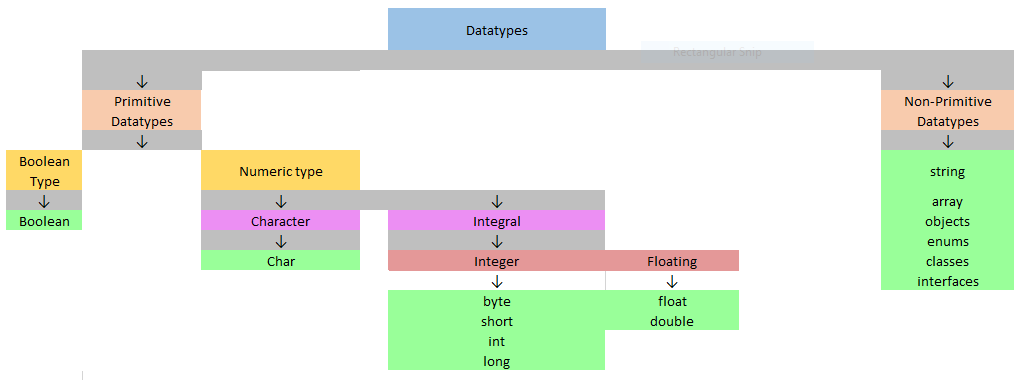Primitive and Non-Primitive Datatypes

Primitive Datatypes:
Primitive datatypes in Java are the fundamental building blocks for storing basic values. They directly hold the actual value and are not composed of other types. Java offers a set of eight primitive datatypes, grouped into four categories:
Integral Datatypes:
byte: Used to store small integer values within a range of -128 to 127.
short: Stores short integer values within a wider range than byte.
int: Holds standard integer values with a larger range than short.
long: Stores larger integer values with an extended range.
Floating-Point Datatypes:
float: Represents single-precision floating-point numbers, suitable for decimal values.
double: Holds double-precision floating-point numbers with higher precision than float.
Character Datatype:
char: Used to store a single Unicode character enclosed in single quotes ('').
Boolean Datatype:
boolean: Represents binary values, either true or false, used in conditional statements.
Non-Primitive (Reference) Datatypes:
Non-primitive datatypes, also known as reference datatypes, are used to store references to objects rather than the actual data. They are more complex than primitive datatypes as they are composed of multiple values and methods. Java's reference datatypes include:
Classes: User-defined blueprints for creating objects, encapsulating data and behavior.
Interfaces: Defines a contract for classes to implement, allowing multiple inheritance-like behavior.
Arrays: Ordered collections of elements, whether primitive or reference datatypes.
Enums: A special type that defines a set of constant values.
Objects: Object is an instance of a class, and the variable holding that object contains a reference to its memory location.
Strings: strings are objects, they are reference datatypes, and variables holding string values contain references to the memory locations where the string data is stored.
Differences between Primitive and Non-Primitive Datatypes:
Memory Allocation:
Primitive: Directly store values, memory allocation is straightforward.
Non-Primitive: Store references to objects, requiring memory for the reference and the object itself.
Size:
Primitive: Fixed size based on datatype.
Non-Primitive: Size varies depending on the complexity of the object being referenced.
Data Storage:
Primitive: Store actual values.
Non-Primitive: Store references to objects that hold the values.
Operations:
Primitive: Support basic arithmetic and logical operations.
Non-Primitive: Support custom methods and behaviors defined in classes.
Default Values:
Primitive: Have default values (e.g., 0 for numeric datatypes, false for boolean).
Non-Primitive: Default value is null, indicating no reference.
Performance:
Primitive: Efficient in terms of memory and performance.
Non-Primitive: May have higher memory overhead due to referencing objects.